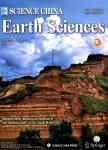Present-day horizontal deformation status of continental China and its driving mechanism
Present-day horizontal deformation status of continental China and its driving mechanism作者机构:Institute of GeologyChina Earthquake AdministrationBeijing 100029China
出 版 物:《Science China Earth Sciences》 (中国科学(地球科学英文版))
年 卷 期:2007年第50卷第11期
页 面:1663-1673页
核心收录:
学科分类:07[理学] 08[工学] 0708[理学-地球物理学] 0704[理学-天文学]
基 金:Supported by the National Natural Science Foundation of China (Grant Nos. 40674036 and 40534023)
主 题:GPS velocity field,continental China,horizontal deformation field,Kriging,shape function,dynamics
摘 要:Based on velocity data of 933 GPS sites and using the methods of Ordinary Kriging interpolation and shape function derivation, this study has obtained the strain rate field of continental China in the spherical coordinates. In comparison with previous research results, it is found that such a strain rate field can be described by both the continuous deformation and block motions in the continent. The Tibetan Plateau and Tianshan region are characterized by continuous deformation which is distributed across the whole area. Within the blocks of South China, Tarim, Ordos, and Northeast China, little crustal deformation and deformation occurs primarily on the faults along their boundaries, which can be explained by the model of block motion. In other regions, such as the Yinshan-Yanshan block, North China block, and East Shandong-Yellow Sea, deformation patterns can be explained by both models. Besides, from southwest to northeast of continental China, there are three remarkable extensional zones of NW trending. These results imply that the NNE directed push of the India plate is the primary driving force accounting for the internal deformation of continental China. It produces the uplift, hori-zontal shortening and vertical thickening of the Tibetan Plateau as well as radiation-like material extru-sion. Of these extruded materials, one part accommodates the eastward escape of other blocks, generating convergence and compression of western China and widespread extension and local com-plicated deformation in eastern China under the joint action of the surrounding settings. The other part opens a corridor between the South China block and Tibetan Plateau, flowing toward southeast to the Myanmar range arc and filling the gap there which is produced by back-arc extension due to plate subduction.



